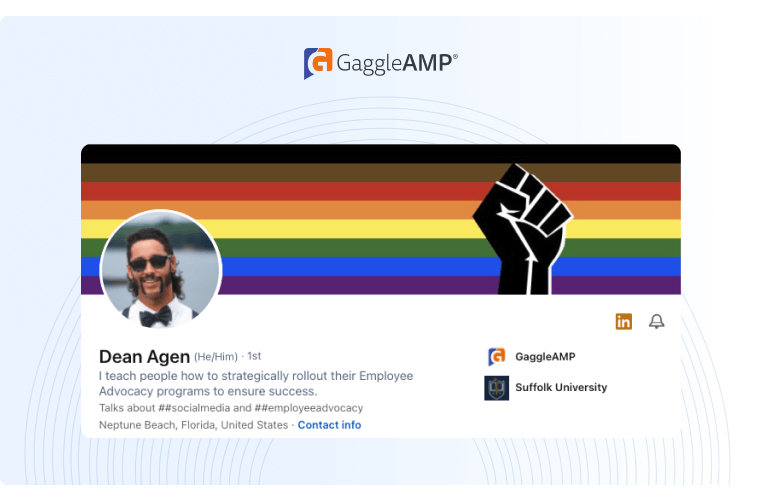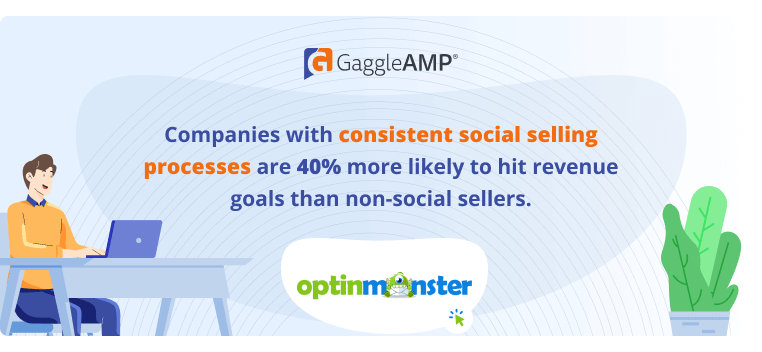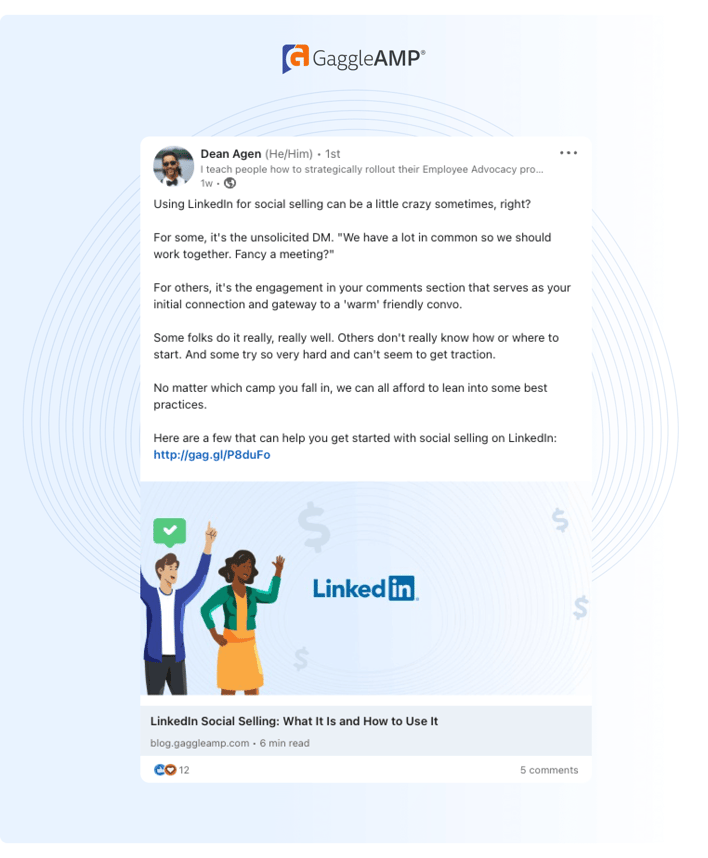7 Steps to Implement an Effective Social Selling Strategy
Are you ready to take your sales efforts to the next level? Get your sales team involved on social media by integrating social selling into your sales strategy.
According to a survey by IDC, 84% of C-level/vice president (VP) executives and 75% of B2B buyers use social media to make purchasing decisions. A social selling strategy can be a great differentiator for your sales team and help them meet qualified leads where they are.
The goal of social selling is to build authentic relationships with potential clients. By sharing relevant and helpful content on social media, your sales reps and your organization will stay top of mind for potential customers.
What Is a Social Selling Strategy?
A social selling strategy is a plan of action put in place by organizational leaders to help their sales reps make connections and build meaningful relationships with potential buyers on social media platforms like LinkedIn.
Social selling is not strictly about selling — it’s about engaging with and building trust with potential buyers so they’ll be more willing and ready for a sales conversation when the time comes. With a social selling strategy, sales reps can nurture strong relationships with prospects which leads to more successful sales outcomes.
How to Implement a Social Selling Strategy
So, how do you develop a social selling strategy? Follow these steps to help your sales team members become social sellers.
1. Align Sales and Marketing Leadership
Social selling is a great way to improve upon an organization’s existing sales strategies. For a social selling strategy to be successful, you should have support from executive leadership, especially those in sales and marketing.
 With social selling, sales reps share content on social media that will help them engage and start conversations with potential buyers. Marketing plays a role in this by providing sales teams with content and messaging that will speak to ideal prospects.
With social selling, sales reps share content on social media that will help them engage and start conversations with potential buyers. Marketing plays a role in this by providing sales teams with content and messaging that will speak to ideal prospects.
As you begin the process of establishing a social selling strategy, there are a few things to consider:
- What are the primary goals of your social selling strategy?
- Are there specific metrics you’ll use to evaluate social selling performance?
- How will your existing sales strategies and marketing programs support your social selling strategy?
- What types of content and messaging should your salespeople be sharing on social media?
- Are there any social selling examples you can show your team to help them understand how to engage?
When your organization is aligned on goals and success markers, it makes the transition to a social selling strategy much smoother.
2. Determine Which Social Networks to Leverage
LinkedIn social selling has become quite popular and is the social platform most often used by sales reps. Twitter, Facebook, and even TikTok are other social media channels that can be used for social selling, too. If you’re not sure where to begin, choose the social media platform where your ideal client is most active.
That being said, there’s a reason why LinkedIn is the top choice for social selling. LinkedIn is a social network that’s primarily business and career-focused. This means sales reps can find many potential buyers who might be interested in a sales conversation about the products and services they have to offer. In fact, 76% of buyers are ready to have a conversation over social media. When salespeople share relevant and insightful content, 62% of B2B buyers will respond to them.
 Once you’ve decided which social media platforms your team will use, you can begin to implement your social selling strategy.
Once you’ve decided which social media platforms your team will use, you can begin to implement your social selling strategy.
3. Help Your Sales Team Set Up Their LinkedIn Profiles
A social media profile is where a sales rep can let their personal brand shine. The LinkedIn profile outlines who the salesperson is, how they help their ideal client, and the value and results they provide to their customers.
 The profile photo is one of the first things a prospect will see when exploring a LinkedIn profile. It’s important that the profile photo is professional and an authentic representation of the sales rep.
The profile photo is one of the first things a prospect will see when exploring a LinkedIn profile. It’s important that the profile photo is professional and an authentic representation of the sales rep.
Include keywords in the LinkedIn headline, summary, and job description sections that are relevant to your ideal client. These keywords make it easier for prospective buyers to find the LinkedIn profile in search results and hopefully start a conversation with the salesperson.
4. Train Your Sales Team in Social Selling
After your sales team has set up their social profiles, provide social media training so they feel well-equipped to use social selling in their sales process. They should have a clear understanding of the social media features and tools they’ll be using to research and connect with potential buyers.
LinkedIn Sales Navigator is one of LinkedIn’s most powerful sales tools to help sales reps connect with potential customers. It offers advanced search features, customized lead recommendations, and more. For example, Genesys, a software company, found that their sales reps who used Sales Navigator increased their pipeline growth 2.2X faster and achieved a 16% higher win rate than the sales reps who didn’t use it. You can also teach them how to create compelling copy that resonates with their target audience. There are plenty of guides on crafting compelling social media content, or you can invest in a virtual sales coaching program that provides more detailed social media content creation techniques.
5. Provide Content That Sales Reps Can Share
Content is key to the success of your social selling strategy. Sharing content that’s relevant to potential customers helps salespeople build credibility and boost engagement on social media. This ultimately helps them connect with more people that would be a good fit for your brand’s products and services.
An actual LinkedIn post shared from GaggleAMP’s employee advocacy efforts.
A social selling strategy pairs well with an employee advocacy program. With an employee advocacy program, content is curated by the marketing team. The marketing team manages the messaging and type of content that can be shared. Industry research and reports, case studies, and customer testimonials are great types of content to share.
Use promotional content sparingly so you don’t overwhelm followers and connections. According to the Sprout Social Index, 60% of social media users are annoyed with too many promotions by brands and 46% of people will unfollow a brand if they receive too many promotional messages.
An employee advocacy platform makes sharing on social media simple for sales reps. They’ll log into the platform and find content to share that’s been approved by the marketing team. Plus, employee advocacy platforms help to gamify the process of sharing content and incentivize sales reps to post on social media to reach potential customers.
6. Network and Build Connections With Leads and Buyers
The goal of social selling is to develop authentic and trusting relationships with prospective customers. Through social media, sales reps can search for ideal clients, share valuable information, and connect with qualified leads.
Social Selling Techniques
Here are some social selling tips and tricks to integrate into your sales process:
-
Grow your social network by searching LinkedIn for organizations you’d like to work with, create a list of the main decision-makers at the organization, and engage with the content they share on social media.
-
Join LinkedIn groups that are relevant to your target audience and share helpful posts and engage in conversations in the comments section.
-
Send connection requests to potential buyers who viewed your profile or engaged with your content by liking or commenting on a post.
-
Personalize connection requests by taking a look at a prospect’s profile to find specific talking points and mutual connections.
-
Respond to LinkedIn messages and comments in a timely manner.
-
Keep track of performance metrics like LinkedIn’s Social Selling Index (SSI) to help measure success.
7. Evaluate Your Social Selling Strategies
It might take some trial and error to find the social selling strategies and techniques that work best for your sales team. Evaluate your social selling strategy regularly to see if goals are being met.
These are a handful of questions to ask as you determine the success of your social selling strategy:
- Are sales reps integrating social selling into their daily workflow?
- Are prospects more engaged in social media conversations compared to other sales communication channels (ex. email outreach, cold calling phone, etc.)?
- Are leads moving through the sales funnel at a faster rate when social selling is used?
- Are sales reps meeting or exceeding their sales quotas?
The success of your social selling strategy will be dependent on whether or not sales leaders provide guidance and support to their sales teams. Let’s say only a few of your salespeople have adopted social selling. Ask the sales team members who aren’t engaging in social selling what roadblocks they’re facing and remove any barriers that might be preventing them from implementing social selling techniques.
 Companies with consistent social selling processes are 40% more likely to hit revenue goals than non-social sellers.
Companies with consistent social selling processes are 40% more likely to hit revenue goals than non-social sellers.
Approaching social selling strategically instead of haphazardly will help your sales team find success. Your social selling strategy will be even more effective when paired with an employee advocacy program. Sales reps won’t need to scramble to find impactful content to share with their followers. This in turn gives them more time to research and engage with ideal clients on social media.












